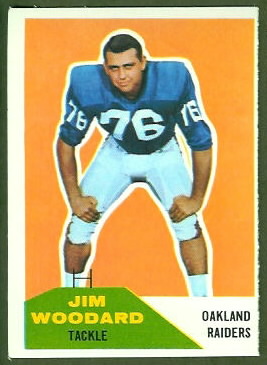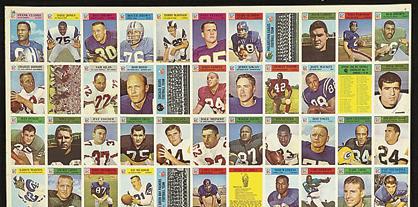U is for Uncut Sheets
March 6th, 2010 | Published in ABCs of Vintage Football Cards, error cards, General Collecting Info, Interesting Message Board Threads
Occasionally you will see uncut sheets of vintage cards up for sale. Studying uncut sheets can give you insight into why some cards are much harder to find than others. For example, by looking at the uncut sheets for a set, you can see why some cards are considered short prints or double prints. For most sets, the price guides indicate which cards are short prints or double prints, and they adjust the cards’ prices accordingly. I say most, because some short prints are not documented–those in the 1964-1967 Philadelphia sets, for instance.
Short prints and double prints are just part of the story. A card’s position on an uncut sheet can also affect its scarcity, because cards on the corners and edges of the sheets were more likely to be damaged in production. I have not seen this factored into price guides’ prices, though: if two common cards were printed in equal numbers, the price guides will usually–if not always–assign them the same price.
The price guides do assign higher prices to the first and last cards in a set, asserting that the first and last cards generally got more wear than the other cards. Supposedly, lots of kids sorted their cards into numerical order, put rubber bands around them, and banged them around. In practice, though, I find that first and last cards aren’t noticeably scarcer in high grades than the other cards, unless they happened to be on the corners and edges of the sheets.
A recent–and timely!–thread in the Collectors Universe forums includes pictures of numerous uncut baseball card sheets and a nice discussion about short prints and double prints. The thread shows the patterns that the card companies used when arranging cards from sets of different sizes on the sheets. Depending on the size of the set (or series within a set), the card companies repeated rows of cards on the sheets in different patterns. I recommend reading the thread.
 Pictured here is the card I always use as an example of one that is scarce because of its position on the sheet. It’s a 1960 Fleer Jim Woodard card, and it was in the bottom-left corner of the sheet. The Woodard is easily the toughest card in the set–PSA has graded only four of them 7 or better–and a PSA 8 would sell for hundreds of dollars on eBay. Most other PSA 8 1960 Fleer commons sell for $10-20.
Pictured here is the card I always use as an example of one that is scarce because of its position on the sheet. It’s a 1960 Fleer Jim Woodard card, and it was in the bottom-left corner of the sheet. The Woodard is easily the toughest card in the set–PSA has graded only four of them 7 or better–and a PSA 8 would sell for hundreds of dollars on eBay. Most other PSA 8 1960 Fleer commons sell for $10-20.
Over the past year, I have put together a number of “virtual” uncut sheets in the Vintage Football Card Gallery, including one for the 1960 Fleer set. I have included a little discussion for each sheet, as well. Rather than repeat the information here, I’ll just point you to the pages for the sheets:
- 1948 Bowman
- 1948 Leaf
- 1949 Leaf
- 1950 Bowman
- 1951 Bowman
- 1952 Bowman Large
- 1953 Bowman
- 1954 Bowman
- 1955 Bowman
- 1956 Topps
- 1957 Topps
- 1958 Topps
- 1959 Topps
- 1960 Fleer
- 1960 Topps
- 1961 Fleer
- 1961 Topps
- 1962 Fleer
- 1962 Topps
- 1963 Fleer
- 1963 Topps
- 1964 Philadelphia
- 1965 Philadelphia
- 1966 Philadelphia
- 1967 Philadelphia
- 1967 Topps
- 1968 Topps
- 1969 Topps
- 1970 Topps Super
- 1971 Topps
Here are more of the ABCs:
- Previous: T is for Topps, Part 4: the 1970s
- Next: V is for Values
- All of the ABCs

